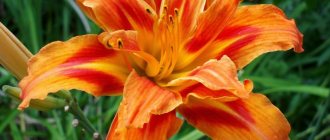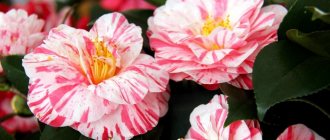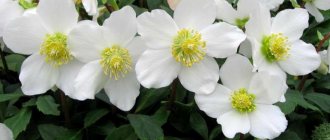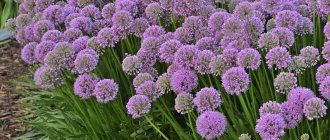Plants that love the sun do well in partial shade, the main thing is that the plants are actively illuminated for at least 6 hours. Daylilies do not have any special requirements for the composition of the soil and can grow and bloom in one place for many years, forming dense, lush clumps.
Yet, how to create the best conditions for growing these spectacular flowers? When to plant daylilies in open ground, in spring or autumn? How to care for plants at different times of the year?
Description of daylily: varieties and varieties
Daylily (Hemerocallis) is a perennial herbaceous plant native to East Asia. Daylilies have been grown in gardens since the 18th century. According to the description, the perennial has a dense rosette of two-row basal leaves that diverge in the form of a fan. The strap-like petals are pointed at the end. The rhizome is powerful with cord-like roots.
Daylily Forgatten Dreams
On a note! The name daylily is translated from Greek as meaning “day” and “beauty.” This emphasizes the beautiful flowering of the plant, which lasts 1 day.
There are about 20 natural species of perennials. They are decorative, unpretentious, and can grow on ordinary soil.
The most famous types:
- red lemongrass;
- yellow;
- lemon yellow;
- Du Maurier;
- Middendorf.
Everyone is familiar with the common orange daylily (Hemerocallis fulva), which can often be found in summer cottages, parks and squares.
Red daylily
Before flowering, the plant throws out 5-20 flower stalks, with a height of 40 cm to 1 m, depending on the variety. 10-30 flowers bloom on each peduncle; the buds do not bloom at the same time. The color of the petals is the most varied (excluding blue shades).
What daylily flowers might look like:
- triangular;
- star-shaped;
- rounded;
- arachnids.
The shape of the petals is corrugated, fringed, terry. Thanks to the efforts of collectors, two-color varieties with a pleasant aroma of flowers and remontant hybrids have been obtained.
Currently, more than 60 thousand varieties and hybrids of daylily have been bred. American and Australian breeders, the authors of the latest new products, strive to create large, densely double flowers of original colors.
Known varieties and hybrids:
- Thin Man is a new hybrid variety with huge flowers up to 25 cm in diameter, on peduncles 1 m high. Thin petals are curled into a spiral, red at the edges. The throat is bright yellow. Each peduncle produces up to 30 buds.
- Mildred Mitchell is a bush 70 cm high. Flowers with a diameter of 18-20 cm are pink-purple in color with a pronounced aroma.
- Moses Fire is a plant 70 cm high, a remontant variety. It blooms in July-August with large double flowers of brick-red color.
- Black Prince is a bush up to 80 cm high. It blooms from mid-July with red-burgundy flowers with a yellow center with a diameter of 15 cm.
- Frans Hals is a medium-sized bush, 40-50 cm. Flowers are 15 cm in size, scarlet in color with a yellow center, with a sweet aroma.
- Jordan – bush height 60 cm, dense rosette of dark green leaves. Corrugated flowers of raspberry-lilac color bloom in August-September.
Daylily variety Frans Hals
Variety selection
There are many varieties of this flower - about 30,000. Different varieties of daylilies with names are unlikely to help you make a choice: the color of the daylily, its flowering time, and in the case of a border or alpine hill, the height of the plant will be decisive.
Breeders are constantly offering amateur flower growers new products - luxurious double varieties, varieties with longer flowering, varieties that can withstand bad weather.
Hybrid daylilies are more capricious than natural flowers. However, they are so beautiful that gardeners spare no effort, time or money on them.
Planting site, soil
Lychnis perennial - planting and care in open ground
Daylily prefers open, well-lit places. Varieties with dark-colored petals fade quickly in sunlight; for such plants, it is recommended to create partial shading during the midday hours. When planted in the shade, the daylily will bloom poorly. The perennial can be grown in containers.
Attention! For successful flowering, daylilies need to be in the sun for at least 6 hours a day.
The plant loves loose fertile loams with a neutral or slightly acidic soil reaction. If the soil on the site is heavy, humus and sand are added to it. Light sandy loam soils are filled with compost. The perennial has a root system with thick roots that are prone to rotting. If groundwater is close, it is necessary to do drainage or plant flowers in high beds.
Reproduction of daylily by bulblets (root thickenings)
Daylily has an interesting root system. In addition to the usual thin roots, it has fleshy, lace-like roots. There are thickenings on them - bulbs, which serve as storage for water and nutrients. It is their presence that helps daylilies calmly endure drought.
If, when transplanting a daylily, you find a detached bulb with roots, you should not throw it away. This small piece of rhizome can become a full-fledged plant in the future.
Prepare a shallow pot and fill it with a light nutrient mixture. Place the bulb in the center of the container and fill with soil to the top. When planting, make sure that after the pot is completely filled with soil, only the very top of the bulb is visible on the surface. Compact the soil only along the edge of the pot so as not to break the root located in the center. Water the soil. The soil should always be moist until the sprout appears.
When and how to plant
Perennial garden geranium - planting and care in open ground
In order for a perennial to grow for many years in one place and bloom profusely, you need to know how to plant daylilies correctly. Planting is carried out in May when the weather is warm or at the beginning of autumn.
How to plant daylily? The landing order is as follows:
- They make a planting hole - place a bucket of peat-humus mixture with 30 g of superphosphate and 30 g of potassium sulfate in the hole. Minerals are thoroughly mixed with the substrate.
- The roots of the plant are dipped in a weak solution of mineral fertilizer for several hours.
- Inspect the root system, removing dry, rotten roots.
- The foliage is cut to a length of 15 cm.
- Planting material is placed in the hole. Carefully ensure that the root collar is 2-3 cm below ground level.
- The plant section is covered with soil, and the soil is carefully but firmly compacted around the stem.
- The bush is watered, the planting circle is mulched with sawdust, peat, and pine needles.
Before you start planting daylilies, you need to consider what space the adult plant will occupy in the garden bed. Some spreading varieties grow more than a meter wide.
Planting in open ground
General information
Daylily, or, as it is popularly called, daylily, belongs to the Asphodel family. The botanical name, Hemerocallis, comes from a combination of the Greek “day” and “beautiful”, inspired by the short duration of its flowering - each bud, once opened, lasts only a day on the bush. Wild representatives of the genus can be found in the Far East. Cultivated species are grown everywhere.
Daylily is a herbaceous perennial; the roots are fleshy, cord-like, forming thickenings or stolons. The leaves are broadly linear, entire, two-rowed; Depending on the variety, they can be straight or curved. Peduncles are leafy; their height can vary from 30 to 150 cm.
Daylily flowers are funnel-shaped, large, the corolla consists of six bent separate petals with a small tube of stamens. Collected in loose inflorescences of up to 10 pieces; 3 buds can open at the same time. Yellowish, pinkish, reddish or brownish shades predominate. The petals are rarely monochromatic, decorated with fancy strokes or specks. Daylilies bloom in summer. The buds are laid abundantly - the flowering of an adult bush can last a month. After pollination, a triangular capsule with glossy black seeds ripens.
Watering and loosening the soil
Perennial phloxes: planting and care in open ground
The perennial is unpretentious, drought-resistant, and tolerates temperature changes well. Caring for daylilies is not particularly difficult. The plant should be watered rarely, but abundantly. Watering is carried out at the root, trying not to get on the foliage. The plant can do without watering for some time, but will bloom less intensely. It is especially important to water the bush in the second half of July, when flower buds are being laid for the next year.
It is important to know! Overwatering has a bad effect on the plant and can lead to rotting of the neck and roots.
Weed and loosen the top layer of soil regularly. At the same time, they try not to touch the root system, which can rot.
Caring for daylilies
Despite all the unpretentiousness of the daylily, it still requires some care. Without proper conditions, plants may begin to get sick, grow stunted, or stop flowering. To prevent this from happening, it is important to provide the crops with optimal care.
Let's take a closer look at what kind of care these ornamental plants need to be provided in the garden and what measures need to be taken to grow a productive ornamental crop.
Caring for daylilies in the garden
Daylily can be called an ideal plant for the garden, since abundant and long-lasting flowering is ensured by minimal care. For example, the flower tolerates drought well, so it does not require frequent watering.
Note: Application of moisture may only be necessary during severe and prolonged drought. In this case, you need to pour one or several buckets of water directly under the root so that the soil is deeply saturated with moisture, and the procedure itself is best carried out in the evening.
During the growing process, only two feedings are required. Only on poor soils is the amount of fertilizer applied increased, but in this case it is important to remember that it is better to slightly underfeed the plant than to cause an overabundance of nutrients. Complex mineral fertilizers are applied for the first time in early spring to stimulate leaf growth. The flowers are fed the second time in August, when the flowering period is over and the plants begin to prepare for winter.
Regardless of the time of fertilizing, it is better to use fertilizers in granules, after which the soil must be watered abundantly. Mulching the bush will also have a positive effect, as it will prevent the loss of moisture and nutrients.
You will find more information on caring for daylilies in the video.
Reproduction
Transplantation and propagation are best done in August. It is at this time that a short period of vegetative dormancy begins. In most cases, the plant is propagated by dividing the bush, but in some cases propagation by seeds is also allowed (Figure 6).
Figure 6. Plant propagation methods
It should be borne in mind that the latter method is used only for breeding new hybrids, since a plant grown from seeds will not retain the species characteristics of the variety.
Pests and diseases
Daylilies are not only unpretentious, but also relatively resistant crops. They rarely get sick, and most pests are repelled by the rich aroma of the flower. However, there are several types of insects that can cause harm to the plant. For example, thrips get inside a plant from the soil and begin to feed on its juices. As a result, the bush becomes weak and the buds have an irregular shape. Unfortunately, there are no effective methods for controlling thrips, and the affected plant must be dug up and burned along with a lump of earth.
An equally dangerous pest is the lily mosquito, which lays eggs in the leaves and buds of the plant. The hatched larvae gnaw holes in the leaves and reduce the decorative value of the crop.
Among the common diseases of daylily are the following pathologies:
- Root rot most often appears in the spring. A characteristic symptom is yellowing of the leaves and stunting of their growth. The affected plant must be carefully removed from the soil, its roots inspected, damaged parts removed, and the remaining parts washed in a weak solution of potassium permanganate.
- Rust only appears if patrinia grows next to the daylily. For prevention, the crop must be regularly treated with fungicides.
- Fusarium is a fungal disease that causes yellowing and drying of leaves, and oppression of the entire plant as a whole. In the early stages, fungicides will help to cope with it, but if the disease has spread greatly, the plant must be burned along with the earthen lump.
To prevent the spread of diseases, you need to regularly inspect the bushes and remove their affected parts, as well as carry out preventive treatments with fungicides and insecticides in small doses.
Reproduction methods
Daylilies can reproduce vegetatively and by seeds. The most convenient way is to divide the bush. It is better to carry out the event in the spring so that the plant has time to take root well before the cold weather. Some plant varieties are easy to separate with your hands, but more often you have to use a sharp knife or shovel.
The bush is divided into several large parts. Each pruning should contain part of the root tissue, 2-3 buds, and several leaves. You can simply cut off the side part from the mother bush. After the procedure, an adult plant is not watered for several days so that the cut site does not rot.
Reproduction by dividing the bush
Proliferation (rooting of inflorescences) is a method of vegetative propagation of daylilies. The peduncle is not removed until the upper part dries. At this time, small rosettes of young plants form in place of the inflorescences. The peduncle is cut off, the foliage is shortened by a third. Seedlings are placed in water for roots to appear. Root formation is stimulated by adding 1-2 drops of Epin or Zircon.
When the roots grow to 3-5 cm, the shoots are planted in small pots. Leave it at home for the winter. They are planted in open ground in May, when the danger of frost has passed.
Daylilies are rarely propagated by seeds. It's a long process. Plants bloom only in the third year. Sowing seeds is justified for breeding purposes or when you need to grow a large amount of planting material.
Interesting information! During seed propagation, the varietal qualities of the mother plant are lost.
Rules for propagation by seeds:
- The seeds are soaked in a 3% solution of hydrogen peroxide (15 ml per 1 liter of water), covered with a plastic bag and put in a dark place. Germination takes from 5 to 15 days. It is necessary to periodically check whether the seeds have hatched.
- When the roots appear, the sprouted seeds are placed on a layer of small pebbles and placed in the light.
- The seedlings develop a root system and small leaves appear. Young bushes can be planted in separate pots.
- Plants are planted in open ground when the leaves reach 15-20 cm in size.
Sowing of seeds is carried out in March. If there is lighting, you can sow the seeds earlier - in January-February.
Separating part of a bush
You can propagate daylilies without digging up the entire plant, but by cutting off only a part of it. The best time for this method of reproduction is early spring or late summer.
Prepare a sharp shovel. To better see the border between the divisions (this is the place where it is easiest to divide the bush), cut off the leaves of the daylily - this is necessary when propagating daylilies in the summer. In spring, when leaves are just beginning to emerge from the ground, there is no need for this. Then place the shovel vertically above this place and, pressing sharply with your foot, cut the bush into two parts.
After this, dig up the part you want to transplant from below and remove it from the ground. Further steps are the same as in the previous method: rinse the roots with water, powder the sections and replant them in a new place.
On the remaining part of the bush, treat the cut with ash, and fill the hole with dry soil and compact it firmly. To prevent the wound from starting to rot, do not water the plant for several days.
This method is most often used to propagate loose bushes, but experienced gardeners also use it for dense bush varieties.
Feeding and replanting
Adult daylily bushes need to be fed three times during the growing season. In May, nitrogen fertilizer is applied to the bush. You should not overfeed the plant. Excess nitrogen leads to an increase in green mass to the detriment of flowering.
During the period of bud formation, perennials are fed with mineral phosphorus-potassium fertilizer. A month after flowering, fertilizing is repeated to ensure the full formation of flower buds for the next year.
Daylily can grow in one place for 8-10 years. Old plants are difficult to rejuvenate; they are overgrown on all sides with small divisions that are difficult to take root. Large bushes are difficult to replant.
Plants are better tolerated when transplanted at the age of 3-5 years. In May or September, the plant is dug up, if necessary, divided into 2-3 parts, and planted in planting holes with a prepared substrate.
Pruning in spring and autumn
It is necessary to trim leaves not only to preserve the attractiveness of the daylily. Experienced gardeners do not recommend categorical pruning of faded leaves, even if the plant loses its decorative effect.
Life processes continue in withered leaves, which is very important for preparing the plant for winter. For these reasons, fall pruning should be done carefully when necessary.
In addition, dried foliage serves as an excellent warming material for the roots of the plant. In the spring, last year's foliage is carefully removed, giving young shoots the opportunity to grow.
Pests and diseases
Daylily bushes can be affected by fungal and viral diseases. Root collar rot is a fungal pathology transmitted by pests. The disease can develop during deep planting or poor soil aeration. To prevent disease, do not allow stagnation of water or overfeeding plants with nitrogen.
Leaf streaking is caused by a fungus. Yellow stripes appear on the foliage, and the above-ground part of the bush turns brown and dries out. The affected leaves are removed, and the daylily is treated with a fungicide.
Rust - red spots on leaves and flowers. Plant growth slows down and flowering intensity decreases. The disease cannot be treated.
Note! Non-infectious diseases appear due to unfavorable weather, violations of planting and care rules.
The main pests of daylily:
- thrips are small sucking insect pests that can be found on the inside of leaves;
- aphids - often attack flowers in hot weather and serve as a carrier of viral diseases;
- spider mite – becomes more active in dry, hot weather;
- root mite - damages leaves and inhibits plant growth.
At the beginning of the growing season, preventive spraying of flowers with systemic insecticides and acaricides is carried out.
Leaf damage by thrips
On a note! The most popular products are: karbofos, inta-vir, fitoverm.
In rainy years, many slugs appear on daylily leaves. To combat them, metaldehyde is used. Blue granules are laid out on the soil surface, 3 pieces per plant.
Features of preparation for winter depending on the region
Preparation for winter holidays depends on the variety, variety of plants, weather and climatic conditions of the region where the garden flower is grown.
In the middle lane
In temperate climates, plants must be prepared in advance for winter rest. The soil under the bushes is loosened and mixed with organic matter and minerals. The top of the soil is covered with a thick layer of humus, dry grass and spruce branches. If a cold winter is expected, the bushes are covered with burlap and foam.
After the snow appears, a large snowdrift is raked over the flowerbed.
In the Volga region
To preserve daylilies in winter, it is necessary to properly cover the plants during frosts.
At the beginning of autumn, the bushes are watered abundantly, fed, and the soil is loosened. Cover the plants with dry grass, leaves, humus and spruce branches. After snow falls, high snowdrifts are raked over the plantings.
In the Urals and Siberia
Severe winter frosts can harm heat-loving plants. Therefore, in northern conditions, flowers should not be covered. Plants are dug completely out of the ground and placed in a cool, dark room during frosts.
Expert opinion
Stanislav Pavlovich
Gardener with 17 years of experience and our expert
Ask a Question
Advice! To store garden flowers, use containers and boxes filled with sand or soil.
Flowering period and after care
Daylily throws out flower stalks, each of which contains 10-30 buds. Every flower blooms in the morning and fades in the evening. At the same time, 2-3 flowers bloom on one peduncle. The flowering period lasts 30-45 days. Early varieties begin to bloom in June, late varieties - in August-September. By selecting a collection of varieties, you can achieve flowering of daylilies in your dacha from early summer to late autumn.
Perennial flowering
Interesting information! There are nocturnal varieties of daylilies, the flowers of which bloom in the evening and fade by morning.
Many gardeners are interested in how to properly care for blooming daylilies. In order for the plant to maintain its decorative appearance, faded flowers must be regularly plucked out. This stimulates new buds to bloom. An unkempt plant with wilted petals looks sloppy.
Characteristics of the daylily flower
A distinctive feature of daylily is its high resistance to drought. This characteristic feature of the culture is provided by fleshy and thick adventitious roots, which are able to provide the plant with the necessary moisture even in dry weather.
Figure 1. External features of daylily
The plant has large flowers of yellow, orange or red-brown hue (Figure 1). As a rule, they are collected in small inflorescences, but no more than three opened buds can appear on the plant at the same time, and the flowering duration of each is about three weeks.
Use in landscape design
Its unpretentiousness, duration of flowering and decorative effect throughout the growing season open up great possibilities for the use of daylily in landscape design. The plant is suitable for single planting and goes well with other plants.
Daylily looks good in group plantings next to astilbe, phlox, and irises. Framing the composition with plants with decorative foliage - hostas, heucheras - looks beautiful. Leaf rosettes of daylily go well with late-blooming perennials - asters, chrysanthemums. A flowerbed with blooming daylilies looks interesting when planted in the background and between bushes of ornamental grasses.
Flower in plant composition
Many gardeners love daylilies for their ease of planting and care, beautiful and long-lasting flowering. Beginning gardeners can be advised to begin their acquaintance with flowers by growing natural species and well-known varieties that have proven themselves to be hardy and winter hardy.
Combination of daylilies in a flower bed
Despite the independent beauty of daylilies, they are often combined in a flowerbed with other flowers. Early varieties are combined with phlox - daylily petals repeat the shape of phlox - the result is a harmonious, beautiful composition. When placing daylilies along the border, they are supplemented with low-growing plants such as hostas. Daylilies are combined in color with each other, achieving a bright, cheerful, original composition.
How to prepare for winter
As soon as the plants have finished blooming, pre-winter work can begin. Mainly:
- pruning faded flower stalks so as not to waste energy on seed ripening;
- reproduction by division and transplantation;
- application of potassium-phosphorus fertilizers;
- removal of the above-ground part (pruning at a height of 10-15 cm from the ground surface);
- providing shelter if necessary (mulch, straw, spruce branches, etc.).
Important! Of all the preparatory activities, pruning leaves is mandatory.
What purpose does removing the above-ground part of the bush serve? This is necessary to:
- rotting foliage did not provoke disease and rotting of the root system;
- ensure the removal of possible pests and their larvae.
Pruning should be carried out when constant sub-zero temperatures are established. Maybe a little earlier or a little later. However, pruning too early may encourage the roots to sprout new shoots.
The pruning procedure consists of several stages:
- Using sharp garden shears, cut out all the stems, retreating 10-15 cm from the surface.
- The trimmed grass is raked and disposed of (possibly in a compost pit if there are no pests).
Soil requirements
The daylily plant is not known for its whims. Almost any land suits him. For abundant flowering, it is advisable to normalize the soil to a comfortable state. The flower prefers a slightly acidic or neutral environment.
General recommendations for leveling the composition of the soil:
- It is advisable to dilute a dry sandy bed with clay.
- Excessively clayey soil is fertilized with compost with the addition of sand.
- The sod-podzolic composition is mixed with compost.
- You can use special mixtures for daylilies, which are sold in stores.
The ideal bed for daylilies is enriched loam with good drainage. If it is not possible to make a drainage system, then you can raise the bed.
Features of cultivation
Under natural conditions, daylily prefers to grow in the shade of bushes on forest edges. In this regard, it can be assumed that in the garden it should be grown in a shaded place. This will be the best choice if the garden is located in Africa, Australia or the southern part of France. If you plant such a plant in a shaded place in the middle zone, then it will not have enough sunlight and heat, especially for hybrid varieties. For flowering to be most effective, the plant requires a lot of sunlight.
Absolutely any soil can be used for planting this plant. However, if you want the flowers to be as beautiful as possible, then you will need a special soil mixture, for this you need to add sand to the clay soil, add clay to the sandy soil, and add compost to the podzolic-turf soil. Nutritious, well-drained loam is best for planting. Remember that the soil must be slightly acidic or neutral. If for some reason you cannot provide good drainage on the site, then raised beds will be needed for such flowers.
Flowers that daylilies go with
In the garden plot, daylily is planted as a solo plant, as well as as a group plant. Such plants look great against the backdrop of shrubs and various trees, for example: paniculata hydrangea, viburnum and bamboo. To create spectacular borders, densely bushy varieties are used, and near stone hills, on the banks of rivers or other bodies of water, it is best to plant small-flowered, low-growing species. Such flowers will also decorate the winter garden, and they can also be cut for a long time.
When planting, it should be taken into account that at the end of the summer the plants lose their decorative effect. In this regard, it is necessary to foresee in advance what flowers to plant next to them, so that they can divert attention from the yellowing and fading daylily. For this, experts suggest using physostegia, loosestrife, ornamental grasses and yarrows of various colors.
Flowers. Day-lily. Daylilies in my garden - continuation.











